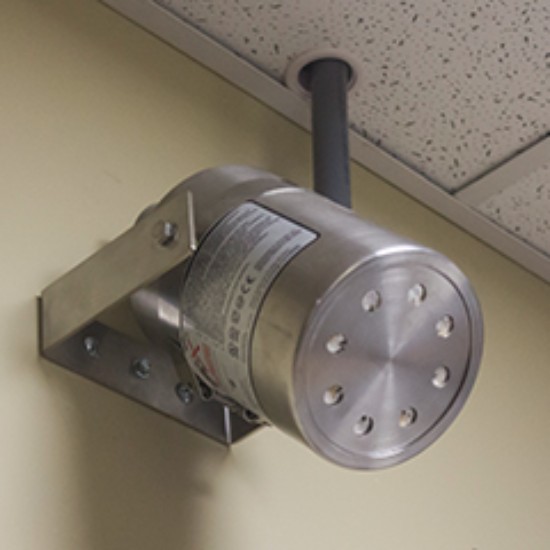
You already know that you do not want a water based sprinkler system in your IT room where the water can harm your expensive electronics. Clean Agent systems are a great option for fire protection in server rooms. You can learn more about using a Clean Agent system in your server room here. Another option for server room fire protection is an aerosol based system called Stat-X. We will outline here the differences between Clean Agent Systems and Stat-X systems to help you determine which option would work best for you.
What components make up the Clean Agent System and Stat-X System?
To understand the differences outlined below, it is important to understand what elements make up the two systems. A Clean Agent System utilizes tanks of up to 1,500 lbs. each and fixed piping to distribute the chemical agent into the server room from the tanks. This system has an independent agent release alarm panel which is connected to your building’s fire alarm panel.
A Stat-X system consists of aerosol canisters/generators ranging from 30 to 2,500 grams, which can be heat activated or connected to an independent agent release alarm panel (which connects to your building’s fire alarm panel). The Stat-X generators hold the Stat-X compound, coolant, and have exit ports on the bottom meaning there is no need for any piping.
Both systems would include components for fire detection, a manual pull station, and alarm components such as horns and strobes.
Room Alterations
As your business grows, so will your server room. Eventually, it may be necessary to reconfigure your space or add on. When that happens, your Life Safety Partner will need to evaluate and reconfigure your fire suppression system to fit the new layout of your server room.
If your Clean Agent tanks are stored in the IT room, the tanks may need to be removed during construction and put back when the construction is complete. If you are expanding the space, you will either need more agent in your current tank(s), which includes shipping the tanks to refilling facilities and awaiting their return, or you may have to get additional tanks. These changes will definitely mean you need to modify your piping, which could include adding additional piping to the current configuration but could also mean replacing your existing piping with a larger size. With the space changes, it is also likely you will need to relocate or extend your detection devices which will include reinstalling or adding items. It’s possible that your space change will require you to start your clean agent system design from scratch. During this time, your system will not be functioning to protect the space.
With a Stat-X system, you may also need to relocate or extend your detection system, which can include reinstalling or adding detection system components. Room alterations will also require you to relocate or extend the flexible releasing circuit, reinstall or add new Stat-X generators. The main differences here are that your system can remain operational throughout the remodel, there is no piping to reconfigure, and no large tanks to add to your system or send for refill.
Preparing a Room for Use
A Clean Agent System must have a sealed room to maintain the gas at certain levels in order to put out the fire and prevent it from reigniting. Learn more on how a room is constructed and tested in order to guarantee correct room pressurization for a Clean Agent System.
Stat-X systems operate at normal room pressurization. This means there is no need to seal the room or test the room’s pressurization capability each year.
Effectiveness of Fire Suppression Method
Clean Agent Suppression works by cooling the fire, removing the heat component of the fire triangle. The source of fire is still present which puts you at risk for a reflash, unless you have a switch that shuts down all power to your server room (which helps with the fire source but can damage your servers). Clean Agent chemicals are designed to maintain fire suppression for 10 minutes, before it dissipates you should have trained personnel respond to the location to watch for any reflash that may occur.
Instead of cooling or displacing oxygen, Stat-X systems break up the fire’s chemical reaction by interacting with the free radicals that fuel the growth of the fire. The chemical agents in Stat-X are 10 times more effective in terms of weight of agent per volume to extinguish the same flammable liquid fire. Also, Stat-X chemical agents can stay suspended in room for hours to prevent reignition, removing the danger of reflash for much longer than 10 minutes.
Environmental Safety
There are different clean agent chemicals, one of the most commonly used agents is FM 200. Both FM 200 and Stat-X chemicals are included in the US EPA’s SNAP list (Significant New Alternatives Policy), which lists acceptable halon alternatives. However, FM 200 has a 4300 GWP/36.5 year atmospheric lifetime, while Stat-X is more environmentally friendly with zero ozone and global warming potential.
Physical Requirements
Space in your server room should be reserved for your valuable electronic equipment. A Clean Agent System does have the capability to store the agent tanks outside of your server room; however, it does present the possibility for problems with your system as there is now piping for your agent outside of the room where the agent would be required to suppress a fire. (Click here for more information about the pros and cons of storing clean agent tanks outside of your server room.)
The Stat-X generators must be in the server room but they are wall mounted and occupy minimal space, saving your server room space for electronics.
A1 is a leading expert on the latest technology in life safety. To find out more information or to ask a question, click here or call us at 1-800-859-6198.
